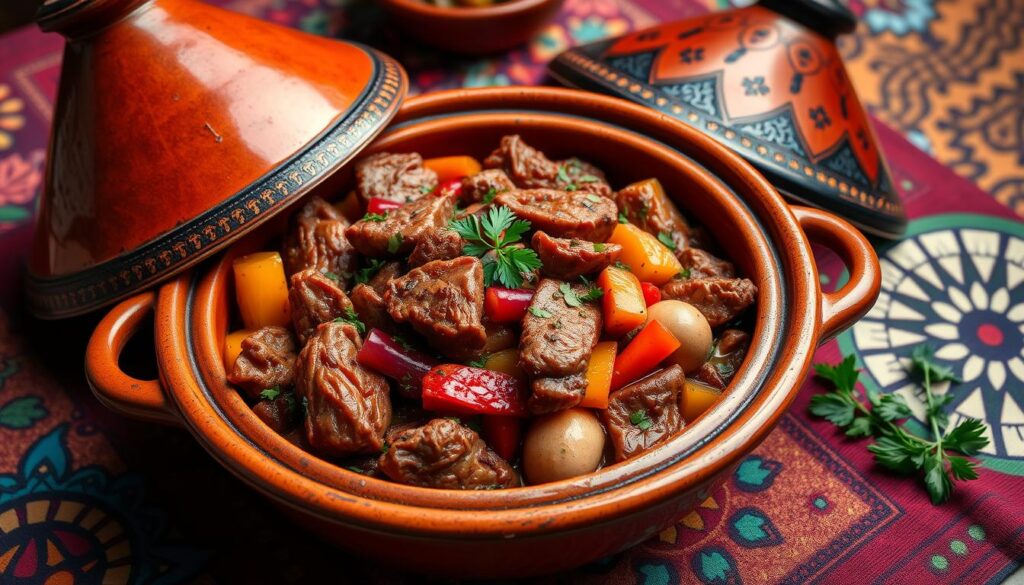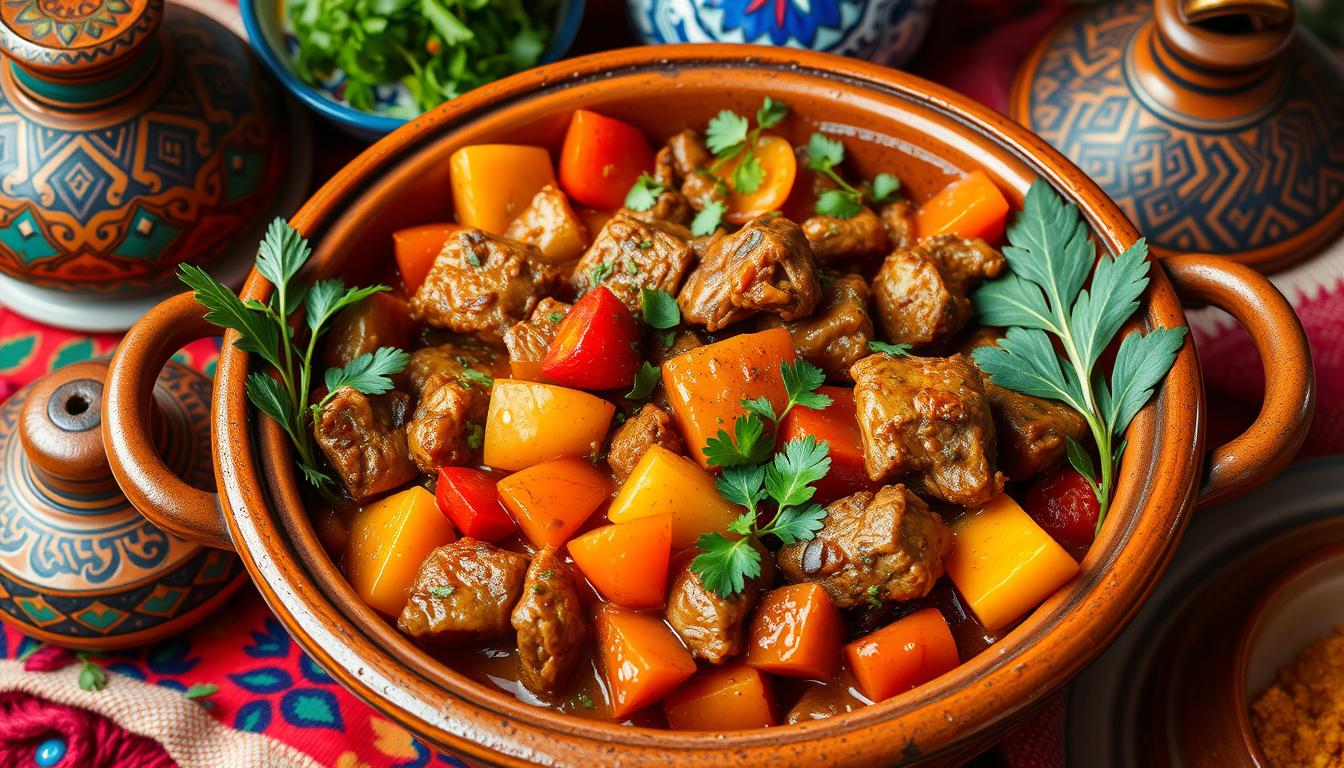I love exploring the rich flavors of Moroccan cuisine. The idea of a slow-cooked tagine, a traditional clay pot stew, takes me to Marrakech. There, the air is filled with spice scents and the sound of happy people enjoying meals.
Today, I’m excited to share a real Moroccan tagine recipe. It lets you bring those amazing flavors into your kitchen.
Key Takeaways
- Discover the essence of traditional Moroccan tagine cooking, a slow-braised stew infused with aromatic spices.
- Learn how to create the perfect Moroccan spice blend to capture the authentic flavors of this North African dish.
- Explore variations of the tagine, including chicken, beef, lamb, or vegetable-based options.
- Understand the cultural significance of the tagine and how it is woven into the rich culinary heritage of Morocco.
- Discover the health benefits of Moroccan cuisine, with its emphasis on wholesome, nutrient-dense ingredients.
What is a Moroccan Tagine?
A Moroccan tagine is a slow-cooked morrocen tagin recipe from Morocco’s north african cuisine. It’s named after the traditional clay pot with a cone-shaped lid used to cook it. This pot lets the dish simmer gently, bringing out the aromatic tagine spices and authentic moroccan flavors.
Traditional Moroccan Clay Pot Cooking
Ceramic tagines have been used in Moroccan cooking for centuries. They might have been influenced by the Romans. The first tagine recipes appeared in the 9th century. These clay pots are both useful for cooking and beautiful to look at.
While tagines can be made from clay, ceramic, or modern materials, clay pots are often preferred. They add an earthy flavor to the dish.
Aromatic Spices and Flavors
Tagines use aromatic tagine spices like cumin, cinnamon, ginger, and turmeric. These spices mix to create the authentic moroccan flavors of the dish. The dome-shaped top of the tagine keeps moisture in, making the meal tender and flavorful.
Tagine recipes often include proteins, vegetables, dried fruits, nuts, and more. These ingredients are cooked slowly to perfection.
“The appearance of tagine-style cooking recipes dates back to the 9th century, and these clay pots serve as both practical cooking vessels and showpieces.”
Ingredients for an Authentic Moroccan Tagine
To make a real Moroccan tagine, you need a few important things. The base is the protein, like chicken, beef, lamb, or vegetables. Next, you add a special Moroccan spice blend, known as ras-el-hanout.
Protein: Chicken, Beef, Lamb or Vegetables
When picking the protein for a Moroccan tagine, you have choices. This lets you pick what you like or what fits your diet. Here are some common picks:
- Chicken pieces, such as thighs or drumsticks
- Beef or lamb chunks
- A mix of vegetables, like carrots, potatoes, and chickpeas
Moroccan Spice Blend
The spice mix is key in a Moroccan tagine. It’s called ras-el-hanout. This mix has spices like:
- Cumin
- Cinnamon
- Ginger
- Paprika
- Coriander
How these spices are mixed can change. Many Moroccan families have their own special ras-el-hanout recipes. These recipes are often passed down through generations.
Step-by-Step Instructions for Making a Moroccan Tagine
Making a Moroccan tagine is a flavorful journey. It starts with a few key steps. First, brown the meat to lock in juices and develop flavor. This is done by searing the meat over medium-high heat until it’s nicely browned on all sides.
Browning the Meat
After browning the meat, focus on the aromatic ingredients. Sauté a thinly sliced yellow onion and 6 cloves of minced garlic in oil or butter until they’re soft and fragrant, about 5 minutes.
Sautéing Aromatics and Spices
Next, add the Moroccan spice blend. This includes saffron, salt, pepper, ginger, paprika, cumin, and turmeric. Toast the spices for a minute or two, letting their aroma infuse the dish.
With the meat browned and aromatics sautéed, it’s time to combine everything. Add the browned meat, broth, honey, preserved lemon slices, green olives, and other ingredients like dried fruit or vegetables. Simmer low and slow, letting the flavors meld and the meat become tender.
By following these steps, you’ll make an authentic Moroccan tagine. It’s bursting with flavor and aroma. Enjoy this North African culinary delight!
Morrocen Tagin Recipe Variations
The traditional Moroccan tagine recipe is a timeless classic. But, there are many variations to explore. You can change the protein and spices to make your own morrocen tagin recipe.
Tagines can have different proteins like chicken, beef, or lamb. Vegetarians can choose a vegetable-based tagine. It can include butternut squash, eggplant, or chickpeas.
Spice blends can be adjusted to your liking. The traditional Moroccan tagine dish uses cumin, coriander, and cinnamon. You can also add herbs and aromatics. Some recipes even include preserved lemons or dried fruit.
- Moroccan Chicken Tagine with Apricots and Olives
- Beef Tagine with Butternut Squash and Chickpeas
- Lamb Tagine with Preserved Lemons and Herbes de Provence
- Vegetarian Tagine with Roasted Eggplant and Tomatoes
- Swordfish Tagine with Lemon and Caper Sauce
These are just a few examples of morrocen tagin recipe variations. Each recipe has its own flavor. This lets you tailor the dish to your taste and your guests’ preferences. Explore the versatility of this north african cuisine and show off your creativity.
“The beauty of a Moroccan tagine lies in its ability to blend the savory, the sweet, and the aromatic, creating a harmonious dance of flavors on the palate.”
Serving and Pairing Suggestions
Serving a Moroccan tagine dish right is key to a great meal. In Morocco, traditional Moroccan bread like flatbread or pita is a must. It’s used to scoop up the stew’s rich flavors. This bread balances the bold tastes and adds a nice texture.
Flavorful couscous or steamed rice are also great with a Moroccan tagine. These grains soak up the sauce’s vibrant flavors. Adding Moroccan salads or roasted vegetables can also enhance the meal, offering a cool contrast to the stew.
| Recommended Pairings | Description |
|---|---|
| Traditional Moroccan Bread | Flatbread or pita, used to scoop up the tagine stew |
| Flavorful Couscous | Absorbs the aromatic sauces of the tagine |
| Steamed Rice | Complements the bold flavors of the Moroccan tagine dish |
| Moroccan Salads | Offer a refreshing contrast to the hearty stew |
| Roasted Vegetables | Provide a flavorful and nutritious side dish |
The right serving and pairing suggestions are crucial for a Moroccan tagine. They make sure your meal is complete and true to North African cuisine.
The Cultural Significance of Tagine
The Moroccan tagine dish is deeply rooted in the country’s rich culinary heritage. It’s not just a meal but a reflection of Morocco’s history and traditions. The iconic tagine pot, with its unique shape, is key to cooking this stew.
The dish uses aromatic spices, preserved lemons, and dried fruits. These ingredients show Morocco’s diverse cultural influences. Over time, each family or region has added their own twist to the dish, creating a rich culinary tapestry.
Moroccan Culinary Heritage
Tagine’s origins come from North African nomadic communities. They used clay pots to cook over fires. The dish’s history goes back to the late eighth-century ruler, Harun al Rashid, and even earlier mentions in The Thousand and One Nights in the ninth century.
Today, tagine is a beloved part of Moroccan cuisine. Classics include lamb with dried prunes or apricots, chicken with preserved lemon and green olives, and fish with tomatoes, lime, and cilantro. Sharing a tagine symbolizes hospitality and togetherness, bringing families and friends closer.
“The traditional Moroccan tagine represents the patience, artistry, and warmth of the Moroccan people, reflecting their love for culinary arts.”
The tagine’s cultural significance goes beyond its taste. It shows the Moroccan people’s passion for their culinary heritage. The slow-cooking process and the use of clay pots highlight their commitment to traditional cooking methods.

Tips for Cooking with a Tagine Pot
Learning to cook with a traditional Moroccan tagine pot is essential for making real moroccan tagine dishes. These clay pots are a key part of north african cuisine. They cook food slowly, making it tender and full of flavor.
Start by heating your tagine pot slowly over medium heat before adding food. This helps the pot and its lid get ready for cooking. Keep the lid on while cooking to keep the moisture and spices inside.
Season your tagine pot before you use it for the first time. This step prevents the pot from cracking. Just rub the inside with oil and heat it for 30 minutes before letting it cool.
- Preheat the tagine pot slowly over medium heat before adding ingredients
- Keep the lid on during cooking to trap moisture and flavors
- Season the pot with oil before its first use to prevent cracking
By following these tips for cooking with a tagine pot, you’ll get better at making morrocen tagin recipe. You’ll enjoy the rich, aromatic flavors of moroccan cuisine at home.
| Tagine Pot Type | Key Features | Advantages |
|---|---|---|
| Unglazed Clay | Porous, natural material | Excellent heat distribution, traditional appearance |
| Glazed Clay | Sealed, non-porous surface | Easy to clean, vibrant colors and designs |
| Aluminum | Lightweight, conductive material | Faster heating, more affordable option |
| Cast Iron | Durable, retains heat well | Versatile for stovetop and oven use, excellent heat distribution |
Health Benefits of Moroccan Cuisine
Moroccan cuisine, like the morrocen tagin recipe and moroccan tagine dish, is full of health perks. It uses ingredients rich in nutrients from north african cuisine, such as veggies, lean proteins, and spices. The slow-cooking of the tagine keeps the nutrients in and blends the flavors beautifully.
Nutritious Ingredients and Cooking Methods
Many Moroccan recipes use healthy fats like olive oil and little sugar. They focus on fresh, seasonal foods and spices that fight inflammation. This makes Moroccan cuisine both healthy and tasty. Here are some key health benefits of moroccan cuisine:
- Chickpeas, a key ingredient, are packed with protein, fiber, and folate. They also have iron, phosphorous, and zinc.
- Turmeric, used in many dishes, fights fungi and microbes. It’s being studied for its effects on cancer, heart disease, and diabetes.
- Ginger, another common spice, is rich in manganese. It helps with mild nausea.
- Couscous, a favorite dish, is made from whole wheat or barley. It’s a nutritious whole grain choice.
- Whole grain bread in Moroccan cooking is made from whole grains. It’s a good source of essential nutrients.
The nutritious ingredients and cooking methods of Moroccan cuisine make it a great choice. It’s both healthy and delicious, perfect for adding health benefits of moroccan cuisine to your meals.

Conclusion
Moroccan tagine is a beloved dish that highlights North Africa’s rich culinary heritage. This slow-cooked stew, made in a clay pot, brings Moroccan flavors to life. By following the steps and using traditional ingredients, you can make a delicious Moroccan morrocen tagin recipe at home.
Whether you choose chicken, beef, lamb, or vegetables, your tagine will be full of flavor. It’s a meal that takes you to the lively markets and family gatherings of north african cuisine. Enjoy the cultural richness and traditions of this iconic Moroccan dish. It’s a unique blend of Berber, Arab, and Mediterranean flavors.
Delicious Moroccan Couscous Recipe: Easy & Authentic

